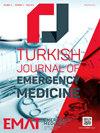某三级医院院内心脏骤停的临床结局与28天生存率相关因素:一项回顾性队列研究
IF 1.1
Q3 EMERGENCY MEDICINE
引用次数: 1
摘要
目的:主要目的是确定院内心脏骤停(IHCA)后自发循环恢复(ROSC)的相关因素,次要目的是确定ROSC后入住重症监护病房(ICU)患者28天死亡率的相关因素。方法:在这项回顾性研究中,我们纳入了2016年7月至2019年4月在某三级医院患有IHCA的患者。定义患者复苏前后特征和事件特征,以揭示与ROSC和28天生存率相关的独立因素。结果:共有254例患者(中位年龄73岁,58.3%男性)接受了心肺复苏(CPR)。ROSC率为45.7%。51例患者(中位年龄63岁,男性54.9%)入住院内icu。28天生存率为31.4%。独立危险因素为慢性肾脏疾病(优势比[OR], 3.18, 95%可信区间[CI], 1.37-7.19, P = 0.007)、慢性阻塞性肺疾病(OR, 2.84, 95% CI, 1.23-6.61, P = 0.015)、作为初始节律的心脏骤停(OR, 2.94, 95% CI, 1.27-6.79, P = 0.012)、多创伤相关并发症(OR, 21.11, 95% CI, 4.71-94.69, P < 0.001)和感染性休克(OR, 4.10;ROSC的95% CI, 1.16-14.54, P = 0.029);28天死亡率脑功能分类评分>2 (OR, 20.86, 95% CI, 2.74-158.65, P = 0.003),急性生理和慢性健康评估II评分>14 (OR, 7.58, 95% CI, 1.06-54.23, P = 0.044)。结论:研究确定了与ROSC和28天死亡率相关的独立危险因素。然而,需要进一步的研究来设计新的策略来增加保留神经功能的出院率。本文章由计算机程序翻译,如有差异,请以英文原文为准。
Clinical outcomes of in-hospital cardiac arrest in a tertiary hospital and factors related to 28-day survival: A retrospective cohort study
OBJECTIVES: The primary aim was to define factors related to the return of spontaneous circulation (ROSC) after in-hospital cardiac arrest (IHCA), and the secondary aim was to determine factors related to 28-day mortality in patients admitted to intensive care unit (ICU) after ROSC. METHODS: In this retrospective study, we included the patients who suffered from IHCA in a tertiary hospital between July 2016 and April 2019. Pre- and post-resuscitation characteristics of the patients and event characteristics were defined to reveal the independent factors associated with ROSC and 28-day survival. RESULTS: A total of 254 patients (median age 73 years, 58.3% males) underwent cardiopulmonary resuscitation (CPR). The ROSC rate was 45.7%. Of all, 51 patients (median age, 63 years, 54.9% males) were admitted to in-hospital ICUs. The 28-day survival rate was 31.4%. The independent risk factors were chronic kidney disease (odds ratio [OR], 3.18, 95% confidence interval [CI], 1.37–7.19, P = 0.007), chronic obstructive pulmonary disease (OR, 2.84, 95% CI, 1.23–6.61, P = 0.015), asystole as an initial rhythm (OR, 2.94, 95% CI, 1.27–6.79, P = 0.012), multi-trauma-related complications (OR, 21.11, 95% CI, 4.71–94.69, P < 0.001), and septic shock (OR, 4.10; 95% CI, 1.16–14.54, P = 0.029) for ROSC; and a cerebral performance category score >2 (OR, 20.86, 95% CI, 2.74–158.65, P = 0.003), Acute Physiology and Chronic Health Evaluation II score >14 (OR, 7.58, 95% CI, 1.06–54.23, P = 0.044) for 28-day mortality. CONCLUSIONS: Independent risk factors related to ROSC and 28-day mortality were defined in the study. However, further studies are needed to devise new strategies for increased hospital discharge with preserved neurologic functions.
求助全文
通过发布文献求助,成功后即可免费获取论文全文。
去求助
来源期刊

Turkish Journal of Emergency Medicine
EMERGENCY MEDICINE-
CiteScore
1.70
自引率
0.00%
发文量
30
审稿时长
22 weeks
期刊介绍:
The Turkish Journal of Emergency Medicine (Turk J Emerg Med) is an International, peer-reviewed, open-access journal that publishes clinical and experimental trials, case reports, invited reviews, case images, letters to the Editor, and interesting research conducted in all fields of Emergency Medicine. The Journal is the official scientific publication of the Emergency Medicine Association of Turkey (EMAT) and is printed four times a year, in January, April, July and October. The language of the journal is English. The Journal is based on independent and unbiased double-blinded peer-reviewed principles. Only unpublished papers that are not under review for publication elsewhere can be submitted. The authors are responsible for the scientific content of the material to be published. The Turkish Journal of Emergency Medicine reserves the right to request any research materials on which the paper is based. The Editorial Board of the Turkish Journal of Emergency Medicine and the Publisher adheres to the principles of the International Council of Medical Journal Editors, the World Association of Medical Editors, the Council of Science Editors, the Committee on Publication Ethics, the US National Library of Medicine, the US Office of Research Integrity, the European Association of Science Editors, and the International Society of Managing and Technical Editors.
 求助内容:
求助内容: 应助结果提醒方式:
应助结果提醒方式:


